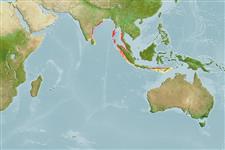Teleostei (teleosts) >
Blenniiformes (Blennies) >
Blenniidae (Combtooth blennies) > Salariinae
Etymology: Blenniella: Diminutive of blennius, Greek,blenios = mucus (Ref. 45335).
More on author: Fowler.
Environment: milieu / climate zone / depth range / distribution range
Ecology
Marine; demersal; depth range 0 - 2 m (Ref. 90102). Tropical
Eastern Indian Ocean: Andaman Islands to Bengkulu, Sumatra.
Length at first maturity / Size / Weight / Age
Maturity: Lm ?, range 3 - ? cm
Max length : 6.0 cm SL male/unsexed; (Ref. 9962); 5.0 cm SL (female)
Dorsal
spines
(total): 12 - 14;
Dorsal
soft rays
(total): 17-20;
Anal
spines: 2;
Anal
soft rays: 19 - 22;
Vertebrae: 37 - 38. Diagnosis: Dorsal fin XII-XIV, 17-20, notched between spinous and segmented-ray portions; anal fin II, 19-22; pectoral rays 13-15; pelvic fin I, 3; caudal fin, procurrent rays 10-14, segmented rays 12-13. Vertebrae 11-12 + 26-27. Orbital cirrus simple filamentous; nasal cirri short and palmate with 2-5 branches; nape with cirri bilaterally. Lateral line, continuous anterodorsally below dorsal spines from 7-8th to 10th, disconnected posteroventrally up to below dorsal spine 9th to 12-13th. Mandibular pores 5-6 Lips margin entire. Occipital crest absent but males have low fleshy median predorsal ridge (Ref. 9962). Body depth at anal-fin origin 5.7-6.8 in SL. Male back with dark brown saddles from dorsal base to middle of side, and midlaterally with a row of blue dashes. Female with dark vertical dark H-shaped bars and many spots posteriorly; dorsal and caudal fins spotted (Ref. 90102).
Specimens were collected from an inner portion of reef flat in small, irregular sand pool, between limestone outcrops with coral fragments, at 0.1 m (Ref. 9962). Adults are found in intertidal zone (Ref. 90102). Oviparous. Eggs are demersal and adhesive (Ref. 205), and are attached to the substrate via a filamentous, adhesive pad or pedestal (Ref. 94114). Larvae are planktonic, often found in shallow, coastal waters (Ref. 94114).
Life cycle and mating behavior
Maturity | Reproduction | Spawning | Eggs | Fecundity | Larvae
Oviparous, distinct pairing (Ref. 205).
Springer, V.G. and J.T. Williams, 1994. The Indo-West Pacific blenniid fish genus Istiblennius reappraised: a revision of Istiblennius, Blenniella, and Paralticus, new genus. Smithson. Contrib. Zool. 565:1-193. (Ref. 9962)
IUCN Red List Status (Ref. 130435)
Threat to humans
Harmless
Human uses
More information
ReferencesAquacultureAquaculture profileStrainsGeneticsElectrophoresesHeritabilityDiseasesProcessingNutrientsMass conversion
Tools
Special reports
Download XML
Internet sources
Estimates based on models
Preferred temperature (Ref.
123201): 28.3 - 29.4, mean 28.9 °C (based on 216 cells).
Phylogenetic diversity index (Ref.
82804): PD
50 = 0.5020 [Uniqueness, from 0.5 = low to 2.0 = high].
Bayesian length-weight: a=0.00741 (0.00335 - 0.01640), b=3.02 (2.83 - 3.21), in cm total length, based on LWR estimates for this (Sub)family-body shape (Ref.
93245).
Trophic level (Ref.
69278): 2.9 ±0.3 se; based on size and trophs of closest relatives
Resilience (Ref.
120179): High, minimum population doubling time less than 15 months (Preliminary K or Fecundity.).
Fishing Vulnerability (Ref.
59153): Low vulnerability (10 of 100).
